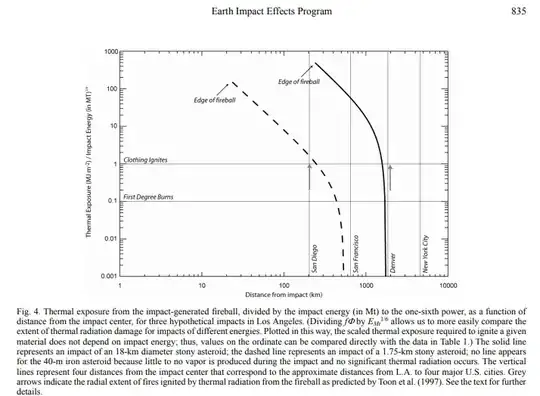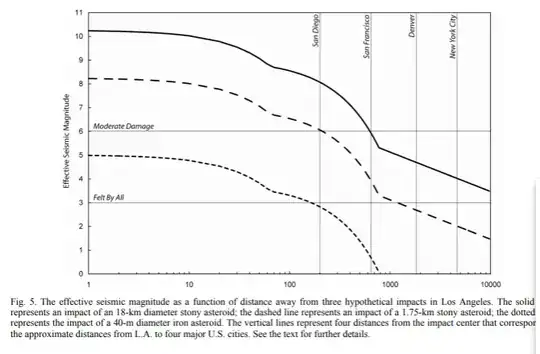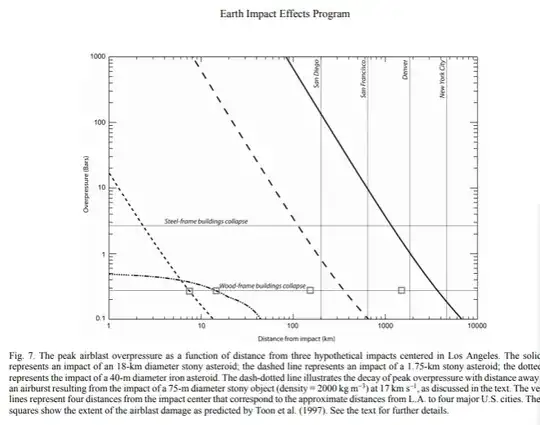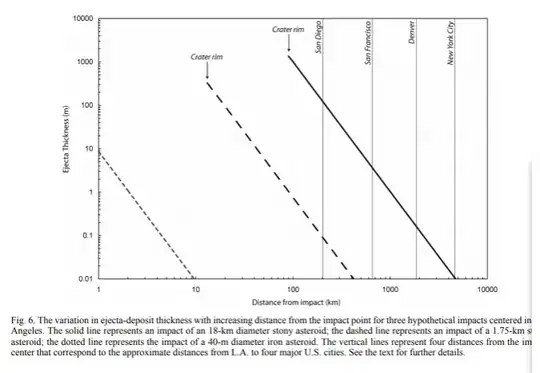Someone has already done a lot of the work - https://www.purdue.edu/impactearth/Content/pdf/Documentation.pdf
Let's parse it out:
Interpolating
Where are we on these charts? These charts assume an 18km asteroid on the top (solid-black) line. This is about 10 times the size of the next lower line. You're hypothetical is about 5x the top-line, so for the rest of this, I'm going to be imagining a line shifted up about half the distance between the solid and dashed line.
London is about 45km in diameter. Or, about 2.5 the 18km diameter rock. So, well take whatever the difference is from the 18km v. ~1.8km lines and multiply it by ${2.5} \over {10}$ or 0.25.
Heat
If I'm reading the chart correctly, the edge of the 1.8km fireball is 400 kilometers. The edge of the 18km fireball is 2,000 kilometers (5x).
Interpolated, each 45km diameter strike will have a $2,000 km \times 5 \times 0.25$ = 2,500 km fireball.
For scale, the fireball will consume half of a continent the size of North America, South America, or Africa.
Everything flammable in this region (cloth, plant matter) will spontaneously combust under the intense heat.

Earthquake
Each strike will be felt anywhere on the planet.
Each strike will also do moderate damage to all structures within roughly 6,000 km of the center (12,000 kilometer diameter). Combined, the three strikes will rattle nearly every structure on the planet with a magnitude 5 or greater earthquake.

Blast
Steel framed structures out to 1,500 km will be knocked down by each strike's airburst blast.
Wooden frame structures out to 6,000 km from the center of the strike will be knocked down.
Probably safe to say all unsheltered life on each stricken continent is dead.

Dust
450km for 1.8km, 4,500 km for 18 (10x). Fine dust will be scattered (4,500 x 10 x 0.25) = 11,250 kilometers radius.
Based on this : https://www.wired.com/2012/05/what-happens-to-all-that-volcanic-ash/ the ash settles at about 10 m/s. It should stay aloft for a few days (arbitrarily saying 14)

Short-Term Environmental Effects
The dust clouds can become electrically charged, disrupting radio and satellite communication. Additionally, they shade the area beneath them from solar heating.
How much shade? Each strike creates an ash cloud 11,000 km in radius. The area of coverage is $\pi r^2$ or 380 million square kilometers. 1.14 billion square kilometers are shaded by all 3 strikes.
The total surface area of the Earth is only 510 million kilometers. So, the entire Earth will be shaded by ash and dust for at least two weeks.
What will this do? According to this article many species of plants can survive on root energy for months or years, but many other plant species can not survive 2 weeks without sunlight. Depending on seed availability, those plants may recover from a new generation of seeds, but the current living plants will probably perish.
Mid-Term Environmental Effects
Based on the 3 strike zones you selected (S. America, Eastern Africa, Chinese coast), parts of Europe and most of North America will be spared the worst, and only will ride out 2 weeks of darkness.
Seedlings, powered by internal food reserves, will sprout in the worst-hit regions before the dust clears. Most food crops only require a few months to mature for harvest. In a few months time, plant life, other than forests, will have recovered.
People and animals that were in shelter (if that was possible) should be able to begin digging out in a few days.
Once the dust clears, satellites and the ground stations to command them should be available to assist in a regional effort to identify survivors and provide assist digging out from the rubble.
Without doing the math, I can't imagine a few weeks of darkness leading to an ice age. However, in the mid term, familiar weather patterns will be disrupted and unfamiliar.
The shock may have been enough to trigger one or more supervolcanoes into eruption. This would create a more persistent ash cloud that might lead to global cooling.
Shutting down for coronavrus shows that without mankind, nature will quickly spring back.
Long Term Environmental Effects
Fission powerplants are very likely not equipped for this. We see at Chernobyl that ruptured plants are survivable, although the incidents of tumors and cancers increases. The new normal would be more frequent cancers.
The human population will be dropped down from 7 billion to the roughly 330 million in N. America, few million in Europe, and however many were fortunate enough to survive in the areas of devastation.



